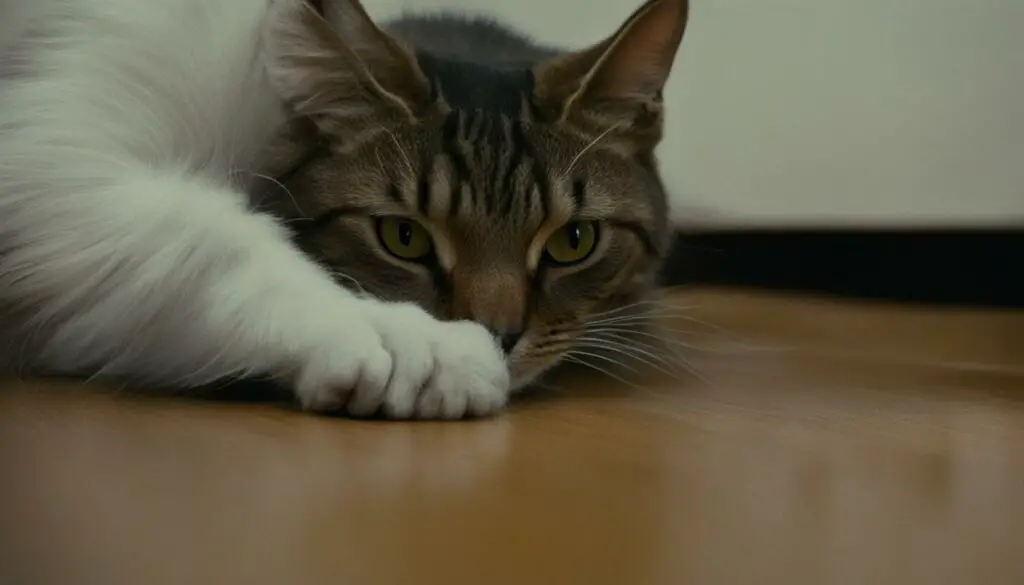As a cat owner, I often find myself worrying when my furry friend starts throwing up. It’s not a pleasant sight, but what concerns me the most is when my cat seems perfectly fine otherwise. So, why does my cat keep throwing up but seem fine?
Before you panic, it’s important to know that occasional vomiting in cats can be normal, especially if it’s due to hairballs. However, if the vomiting is frequent or accompanied by other symptoms, it could be a sign of an underlying health issue that requires attention.
In this article, I’ll delve into the reasons why cats vomit and what it means when they seem fine otherwise. We’ll explore common causes, whether it’s normal for cats to vomit, and when it’s time to seek veterinary care. By understanding the underlying factors and taking appropriate measures, we can ensure our cat’s well-being and prevent any potential health problems.
Key Takeaways:
- Frequent or persistent vomiting in cats should not be ignored and may indicate an underlying health issue.
- Occasional vomiting, especially due to hairballs, is considered normal in cats.
- Monitoring your cat’s vomiting frequency and accompanying symptoms is crucial in determining if a veterinary visit is necessary.
- Common causes of vomiting in cats include hairballs, dietary factors, and various health conditions.
- If your cat is vomiting frequently or the vomiting is accompanied by other signs of illness, it’s important to consult a veterinarian for proper diagnosis and treatment.
Is It Normal for Cats to Vomit?
Vomiting in cats is a common behavior, but is it considered normal? The answer depends on the frequency and accompanying symptoms. Occasional vomiting, especially due to hairballs, is considered normal. Cats groom themselves and may ingest loose fur, which can lead to hairballs and occasional vomiting. However, if your cat vomits more than twice a month or if the vomiting is accompanied by signs of illness such as lethargy or inappetence, it may indicate an underlying health issue that requires veterinary attention.
While occasional vomiting is generally nothing to worry about, persistent or frequent vomiting could be a sign of a more serious problem. Cats are known for their grooming habits, which can lead to hairballs. If your cat is vomiting hairballs occasionally and seems otherwise fine, it is likely within the realm of normal behavior. However, if the vomiting becomes more frequent or is accompanied by other concerning symptoms, it is important to consult a veterinarian to rule out any underlying health conditions.
It’s important for cat owners to be aware of their cat’s vomiting patterns and any potential changes. Keeping track of the frequency and consistency of the vomit, as well as any additional symptoms, can help determine whether it is normal or indicative of a health issue. By being knowledgeable about what is considered normal for a cat’s digestive system, owners can provide the appropriate care and seek veterinary attention when necessary.
| Normal Vomiting in Cats | Abnormal Vomiting in Cats |
|---|---|
| Occurs occasionally, such as hairballs | Occurs more than twice a month |
| Not accompanied by other signs of illness | Accompanied by lethargy, inappetence, or diarrhea |
| Temporary and resolves on its own | Persists or becomes more frequent |
Common Causes of Vomiting in Cats
Understanding the reasons behind why cats vomit can help pet owners determine whether a vet visit is necessary. There are several common causes of vomiting in cats that owners should be aware of. These include: hairballs, ingestion of certain human foods, exposure to toxic plants or foreign objects, parasites, inflammatory bowel disease, and gastrointestinal infections.
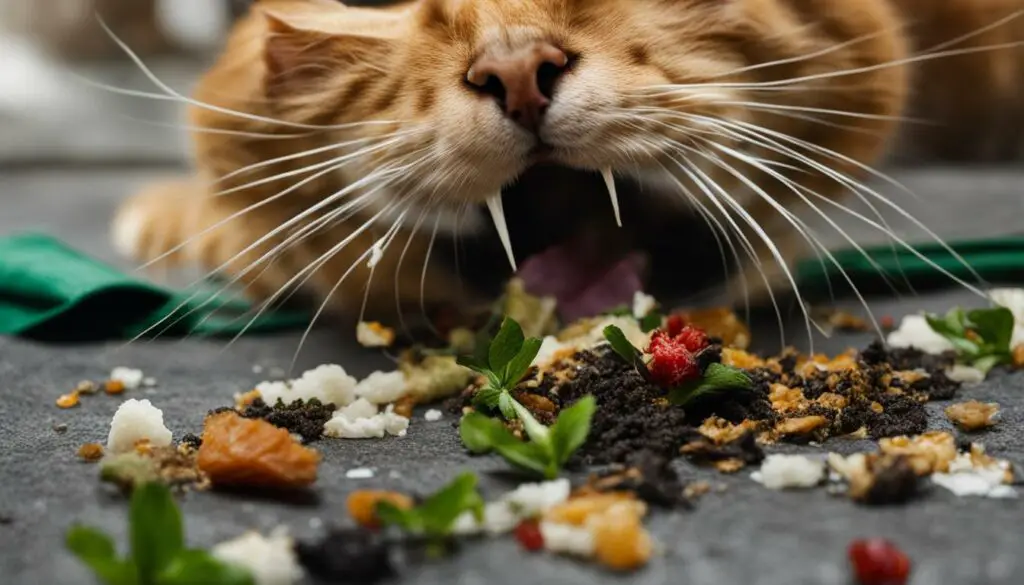
Hairballs are a frequent cause of vomiting in cats. When cats groom themselves, loose fur can accumulate in their stomach and form hairballs. Ingestion of certain human foods, such as dairy products or fatty foods, can also lead to vomiting in cats. It’s important to keep these foods out of reach and avoid feeding them to your cat.
Additionally, cats may vomit if they ingest toxic plants or foreign objects. Indoor and outdoor plants should be carefully chosen to avoid any that are toxic to cats. It’s also important to keep small, potentially dangerous objects out of your cat’s reach.
Parasites, such as roundworms or tapeworms, can also cause vomiting in cats. Regular deworming and preventative measures can help reduce the risk of parasite-related vomiting. Inflammatory bowel disease and gastrointestinal infections are other potential causes. These conditions require veterinary diagnosis and treatment to alleviate the vomiting and manage the underlying issue.
Hairballs: The Feline Vomiting Culprit
If you’ve ever owned a cat, you’re probably familiar with the unpleasant sight of a hairball. These cylindrical masses of fur can be a common cause of vomiting in cats. When cats groom themselves, they often ingest loose fur, which then accumulates in their stomach and forms hairballs. While occasional hairballs are normal, excessive hairballs can lead to discomfort and vomiting.
To prevent hairballs and reduce the frequency of vomiting, regular grooming is essential. Brushing your cat’s fur helps to remove loose hairs and reduce the amount of fur they ingest during self-grooming. Additionally, there are several hairball prevention products available, such as specialized diets and oral lubricants. These products can help to break down the hair and facilitate its passage through the digestive system.
Table: Comparison of Hairball Prevention Methods
| Method | Description | Effectiveness |
|---|---|---|
| Regular Grooming | Brushing your cat’s fur regularly to remove loose hair. | Effective in reducing hairball formation. |
| Specialized Diets | Foods formulated with added fiber or enzymes to aid in hairball digestion. | Can be effective in reducing hairball frequency. |
| Oral Lubricants | Gel or paste products that help hairballs pass through the digestive system. | Effective in facilitating hairball elimination. |
In addition to grooming and using hairball prevention products, it’s important to create a safe and stress-free environment for your cat. Stress can exacerbate grooming behavior and increase the likelihood of hairball formation. Provide your cat with plenty of mental and physical stimulation, as well as a balanced diet, to support their overall well-being.
While hairballs are a common cause of vomiting in cats, it’s important to monitor your cat’s vomiting frequency and consult a veterinarian if the vomiting becomes frequent or is accompanied by other concerning symptoms. Your vet can help determine the underlying cause of the vomiting and recommend appropriate treatment options for your furry friend.
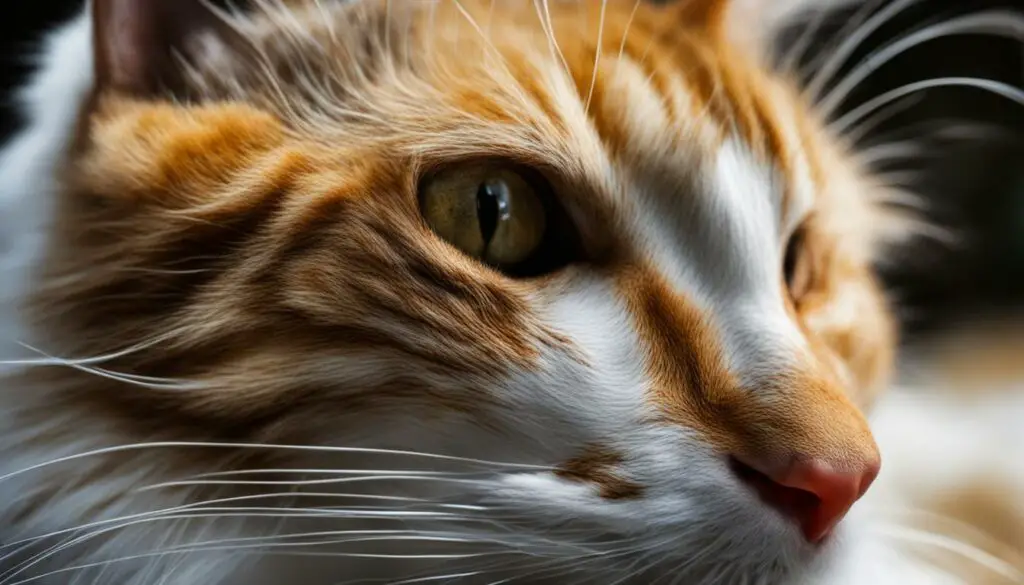
Dietary Factors and Vomiting in Cats
When it comes to the well-being of our feline friends, their diet plays a crucial role. Just like humans, cats can experience vomiting due to dietary factors. It’s essential for cat owners to be aware of these factors to ensure their cat’s health and minimize the risk of vomiting.
Cat food plays a significant role in their overall well-being. Introducing sudden dietary changes can lead to digestive upset and vomiting. It’s important to transition your cat to a new diet gradually, allowing their digestive system to adjust. Additionally, certain human foods can be toxic to cats and can cause vomiting if ingested. It’s crucial to keep these foods away from your furry friend’s reach.
Food allergies are another dietary factor that can contribute to vomiting in cats. Just like humans, cats can have allergies to certain ingredients in their food. Common allergens include chicken, beef, dairy products, and grains. If you suspect your cat has a food allergy, consult your veterinarian for guidance on an elimination diet to identify the culprit and provide a suitable alternative.
| Common Dietary Factors that Can Cause Vomiting in Cats | Symptoms |
|---|---|
| Abrupt dietary changes | Vomiting, diarrhea, digestive upset |
| Ingestion of toxic human foods | Vomiting, diarrhea, lethargy |
| Food allergies | Vomiting, diarrhea, skin rash, itching |
If you suspect that your cat’s diet is causing vomiting, it’s important to consult your veterinarian. They can provide guidance on suitable dietary changes and recommend hypoallergenic or limited ingredient diets for cats with food allergies. Remember, providing a balanced and appropriate diet is key to maintaining your cat’s health and minimizing the risk of vomiting due to dietary factors.
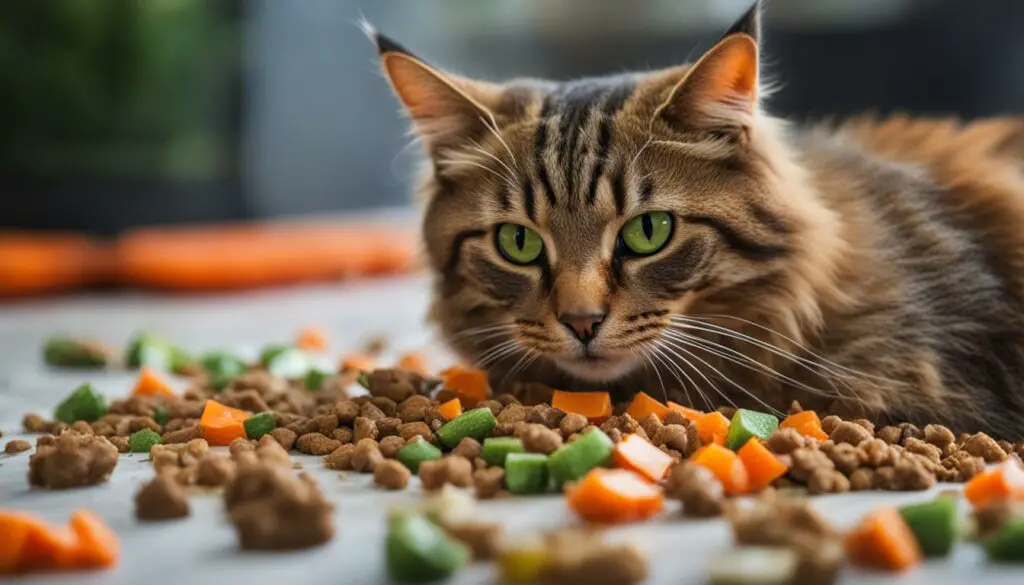
By understanding the dietary factors that can contribute to vomiting in cats, we can take proactive measures to ensure our feline companions stay healthy and happy. Always consult with your veterinarian for personalized advice and recommendations for your cat’s specific needs.
Health Conditions and Vomiting in Cats
Cats can experience vomiting as a symptom of various health conditions. It’s essential for cat owners to be aware of these conditions and recognize when veterinary care is necessary. Some common health conditions associated with vomiting in cats include:
- Kidney disease in cats
- Hyperthyroidism in cats
- Cancer in cats
- Inflammatory bowel disease
In some cases, vomiting may be the only noticeable symptom of these conditions. However, other signs such as weight loss, changes in appetite, lethargy, and diarrhea should also be taken into consideration. If a cat is vomiting frequently or exhibiting other concerning symptoms, it is important to consult a veterinarian for proper diagnosis and treatment.
Table:
| Health Condition | Symptoms | Treatment |
|---|---|---|
| Kidney disease | Vomiting, increased thirst and urination, weight loss | Fluid therapy, dietary management |
| Hyperthyroidism | Vomiting, weight loss, increased appetite | Medication, radioactive iodine therapy, surgery |
| Cancer | Vomiting, weight loss, lumps or masses | Chemotherapy, surgery, radiation therapy |
| Inflammatory bowel disease | Vomiting, diarrhea, weight loss | Dietary management, medication |
It’s important to note that this table is not exhaustive, and there are other health conditions that can cause vomiting in cats. Veterinary consultation is crucial for accurate diagnosis and personalized treatment plans.
Regurgitation: Differentiating from Vomiting
When it comes to our feline friends, regurgitation is a common occurrence that can sometimes be mistaken for vomiting. While both regurgitation and vomiting involve the expulsion of stomach contents, there are important differences to consider.
Regurgitation in cats occurs when they bring up undigested food shortly after eating. This is often a result of eating too quickly or not properly chewing their food. Unlike vomiting, regurgitation is typically passive and effortless, with the food being expelled without any abdominal contractions. It may also include whole pieces of undigested food, lacking the stomach acid or bile that is commonly seen in vomit.
To differentiate between regurgitation and vomiting, it’s essential to observe the cat’s behavior. Regurgitation often happens shortly after eating, while vomiting can occur at any time. Additionally, regurgitated food is typically undigested, while vomit may contain partially or fully digested food, along with stomach acid or bile. Understanding these distinctions can help cat owners identify the cause of their pet’s episodes and take appropriate action.
When to Seek Veterinary Care for Vomiting Cats
Frequent or persistent vomiting in cats can be a cause for concern and may indicate an underlying health issue. As a cat owner, it’s important to monitor your cat’s vomiting frequency and be aware of any accompanying signs of illness. If you notice any of the following, it’s time to seek veterinary care:
- Frequent or persistent vomiting: If your cat is vomiting more than twice a month or the vomiting is becoming more frequent, it’s a sign that something may be wrong.
- Signs of illness: Vomiting accompanied by other symptoms such as lethargy, inappetence, or diarrhea can indicate a more serious underlying condition.
While occasional vomiting may not require immediate veterinary attention, it’s always best to consult with a veterinarian if you have concerns about your cat’s health. They can provide a proper diagnosis and recommend appropriate treatment options to ensure your cat’s well-being.
| Signs to look for when deciding to seek veterinary care for vomiting cats |
|---|
| Frequent or persistent vomiting |
| Accompanying signs of illness such as lethargy, inappetence, or diarrhea |
Remember, as a cat owner, you play an important role in determining when your cat needs veterinary care. Trust your instincts and consult with a veterinarian if you have any concerns about your cat’s vomiting frequency or overall health.
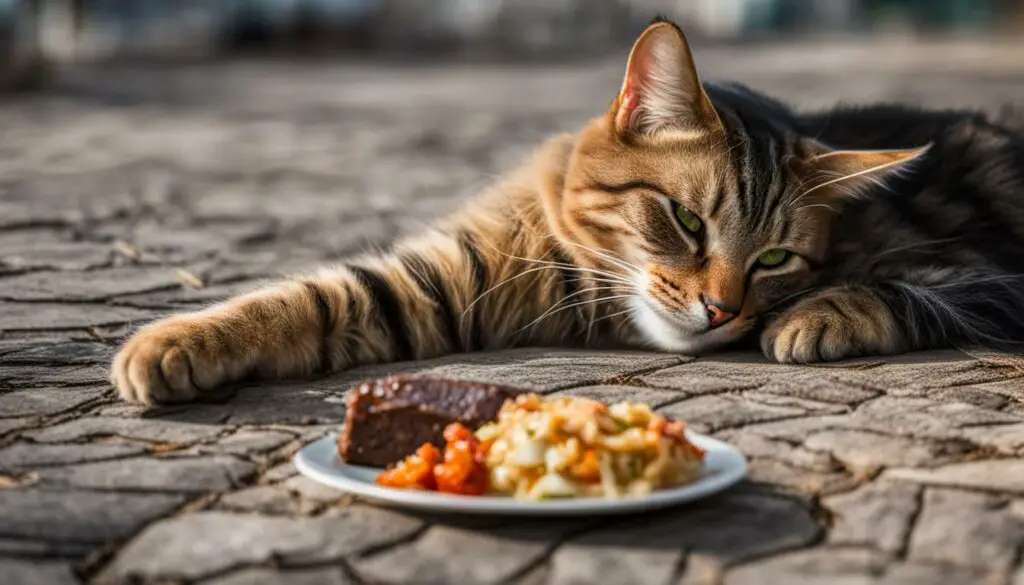
The Importance of Prompt Veterinary Care
Seeking timely veterinary care for vomiting cats is crucial for several reasons. First, frequent or persistent vomiting can lead to dehydration and nutritional imbalances, which can be harmful to your cat’s health. Additionally, vomiting can be a symptom of underlying health conditions that require proper diagnosis and treatment. By addressing the vomiting issue promptly, you can prevent further complications and ensure the well-being of your feline companion.
Diagnostic Process for Vomiting Cats
When a cat exhibits frequent or persistent vomiting, a veterinary visit is necessary to determine the underlying cause. The diagnostic process for vomiting cats typically involves a thorough examination by a veterinarian and may include diagnostic testing such as bloodwork.
During the veterinary examination, the veterinarian will assess the cat’s overall health and look for any signs of illness. They may ask questions about the cat’s diet, behavior, and any other symptoms or changes in their routine. This information helps the veterinarian gather important clues about the potential cause of the vomiting.
In addition to the examination, diagnostic testing may be recommended to further evaluate the cat’s condition. Bloodwork is a common diagnostic test used for vomiting cats. It can provide valuable information about the cat’s organ function, detect any abnormalities in blood cell counts or electrolyte levels, and help identify potential underlying health conditions.
| Diagnostic Testing Options | Purpose |
|---|---|
| Bloodwork | Assess organ function and detect abnormalities |
| Imaging (such as X-rays or ultrasound) | Visualize the cat’s internal organs and identify any abnormalities |
| Fecal testing | Detect parasites or abnormal bacteria in the cat’s stool |
| Urinalysis | Evaluate kidney function and detect any urinary tract issues |
Based on the results of the examination and diagnostic testing, the veterinarian can make a diagnosis and develop an appropriate treatment plan for the vomiting cat. Treatment options may include medication to alleviate symptoms, dietary changes, or addressing any underlying health conditions.
Remedies and Management for Vomiting Cats
When it comes to managing cat vomiting, there are several at-home remedies and treatments that can help alleviate the issue. However, it’s important to remember that these remedies should be used in conjunction with advice from a veterinarian, especially if the vomiting is persistent or accompanied by other concerning symptoms.
Feeding Strategies for Vomiting Cats
One of the first steps in managing cat vomiting is to evaluate the cat’s feeding habits and make necessary adjustments. Feeding smaller, more frequent meals throughout the day can help prevent overeating and reduce the likelihood of vomiting. Additionally, using slow-feeders or puzzle feeders can encourage cats to eat at a slower pace, minimizing the chances of regurgitation.
Certain dietary modifications may also be beneficial for cats prone to vomiting. For instance, switching to a highly digestible cat food or a hypoallergenic diet can help reduce gastrointestinal irritation and food sensitivities. It is recommended to consult with a veterinarian to determine the most appropriate diet for your cat’s specific needs.
Home Remedies for Vomiting Cats
There are several home remedies that can provide temporary relief for vomiting cats. One common remedy is offering small amounts of plain, unsalted chicken broth or electrolyte solution to keep the cat hydrated. However, it’s important to introduce these liquids gradually and monitor the cat’s response, as some cats may have dietary restrictions or sensitivities.
If hairballs are suspected to be the cause of vomiting, grooming the cat regularly can help prevent excessive hair ingestion. This can be done using a soft brush or a grooming glove to remove loose fur. In addition, specialized hairball remedies, such as hairball lubricants or cat grass, can aid in the passage of hair through the digestive system.
When to Seek Further Veterinary Care
If the vomiting persists despite these at-home remedies, or if it is accompanied by other concerning symptoms such as lethargy, weight loss, or blood in the vomit, it is crucial to seek further veterinary care. A veterinarian will be able to perform a thorough examination, conduct diagnostic tests, and recommend appropriate treatment options to address the underlying cause of the vomiting.
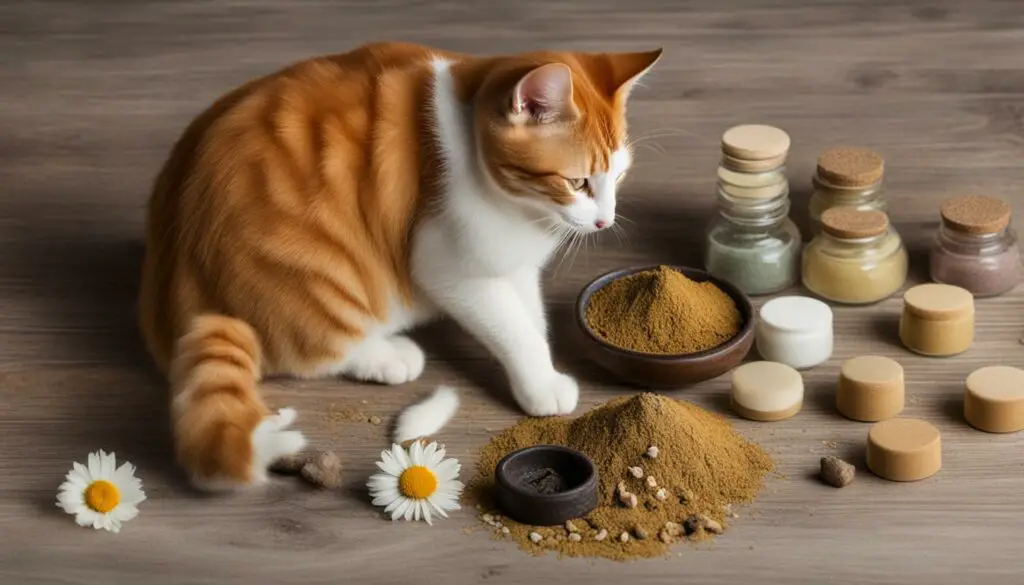
| Treatment | Description |
|---|---|
| Feeding smaller, more frequent meals | Reduces overeating and minimizes the chances of vomiting |
| Using slow-feeders or puzzle feeders | Encourages slower eating pace, preventing regurgitation |
| Switching to a highly digestible cat food | Reduces gastrointestinal irritation and food sensitivities |
| Offering small amounts of plain, unsalted chicken broth or electrolyte solution | Keeps the cat hydrated and provides temporary relief |
| Grooming the cat regularly | Prevents excessive hair ingestion and aids in hairball passage |
Prevention Strategies for Cat Vomiting
Cat vomiting can be distressing for both the pet and the owner. To help minimize the occurrence of vomiting in cats, there are several prevention strategies that can be implemented:
Cat-proofing the environment
Cats are curious creatures, and they may ingest objects that can cause vomiting. To prevent this, it’s important to cat-proof the environment by removing any small objects, toxic plants, or potential hazards that a cat may be tempted to swallow.
Regular grooming for hairball prevention
Hairballs are a common cause of vomiting in cats. Regular grooming can help reduce the amount of loose fur that cats ingest while grooming themselves, ultimately reducing the frequency of hairballs and vomiting episodes. Brushing your cat’s fur frequently can help remove loose hair and prevent it from being swallowed.
Balanced cat diet
A balanced diet is essential for a cat’s overall health and can help prevent vomiting related to dietary issues. It’s important to feed your cat high-quality cat food that meets their nutritional needs. Avoid feeding them human foods or sudden changes in their diet, which can trigger digestive upsets and vomiting.
Keeping a consistent routine
Cats thrive on routine and can become stressed or anxious when their routine is disrupted. A consistent daily routine can help minimize stress levels and reduce the likelihood of vomiting. Stick to a regular feeding schedule, maintain a clean litter box, and provide a comfortable and secure environment for your cat.
By implementing these prevention strategies, cat owners can help reduce the occurrence of vomiting and ensure their furry friends stay healthy and happy. However, it’s important to note that if vomiting persists or is accompanied by other concerning symptoms, it’s best to consult a veterinarian for further evaluation and guidance.
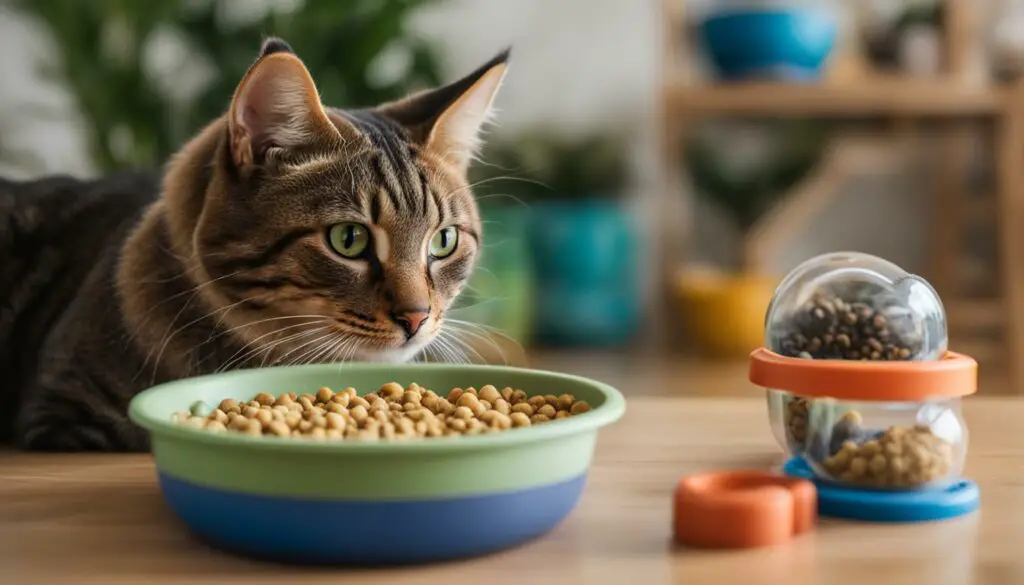
Recognizing Abnormal Vomiting in Cats
Vomiting is a common behavior in cats, but it’s important for cat owners to be able to recognize when vomiting becomes abnormal. Abnormal vomiting in cats refers to frequent or persistent vomiting, vomiting accompanied by other signs of illness, or vomiting that contains blood or foreign material. These signs may indicate underlying health issues that require veterinary care.
One of the key signs of abnormal vomiting in cats is the frequency and persistence of the episodes. If your cat is vomiting more than twice a month or if the vomiting is becoming more frequent, it’s important to seek veterinary attention. Additionally, vomiting that is accompanied by other signs of illness such as lethargy, inappetence, or diarrhea should also be cause for concern.
Dehydration is another important indicator of abnormal vomiting in cats. If your cat is not drinking enough water or if you notice signs of dehydration such as dry gums, sunken eyes, or lethargy, it’s crucial to consult a veterinarian. Dehydration can worsen the cat’s condition and lead to further complications.
Seeking veterinary care is essential when it comes to abnormal vomiting in cats. A veterinarian will be able to perform a thorough examination, run necessary tests, and provide an accurate diagnosis. Treatment options will depend on the underlying cause of the vomiting, and early intervention can help prevent further complications and improve the cat’s overall health and well-being.
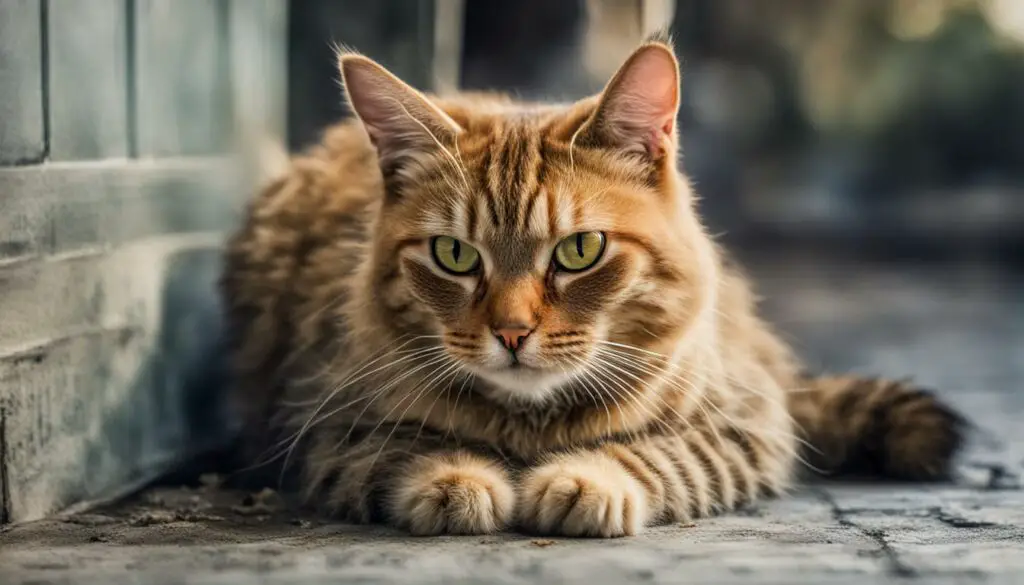
Understanding the Impact of Vomiting on Cats’ Well-Being
Cat well-being is directly influenced by various factors, including their overall health and the presence of any medical issues. Vomiting in cats can have a significant impact on their well-being, affecting their quality of life and daily routines. Frequent or persistent vomiting can lead to discomfort, dehydration, and nutritional imbalances, which can compromise a cat’s physical health and overall happiness.
Vomiting episodes can cause cats to feel uncomfortable and unsettled, disrupting their normal routines and potentially leading to stress and anxiety. Cats may become reluctant to eat or drink due to fear of triggering another vomiting episode, resulting in weight loss and a decline in overall health. Additionally, the presence of vomit in the household can create an unpleasant environment for both the cat and their human family members, further impacting the cat’s well-being.
Managing a cat’s health is crucial in minimizing the impact of vomiting on their well-being. By addressing the underlying causes of vomiting, such as hairballs, dietary issues, or health conditions, cat owners can help alleviate discomfort and improve their feline companion’s quality of life. Regular visits to the veterinarian, proper diagnosis, and appropriate treatment options can help manage vomiting issues and ensure that the cat’s overall health and well-being are maintained.
The Importance of Cat Wellness
Cat owners play a vital role in maintaining their pet’s well-being by implementing preventive measures, providing a balanced diet, and ensuring regular veterinary care. Regular grooming to minimize hairballs, cat-proofing the environment to prevent ingestion of foreign objects, and offering a nutritionally complete diet can help reduce the frequency of vomiting episodes and promote a healthier lifestyle for cats.
Furthermore, managing a cat’s health extends beyond addressing vomiting issues. It also involves maintaining a clean and comfortable living environment, providing mental stimulation through play and interaction, and monitoring any changes in behavior or physical appearance that may indicate an underlying health concern. By focusing on comprehensive cat wellness, owners can proactively address potential issues and promote a higher quality of life for their feline companions.
| Effects of Vomiting on Cats’ Well-Being | Preventive Measures |
|---|---|
| Discomfort and unease | Regular grooming to minimize hairballs |
| Dehydration and nutritional imbalances | Cat-proofing the environment to prevent ingestion of foreign objects |
| Reluctance to eat or drink | Providing a balanced and nutritious diet |
| Stress and anxiety | Maintaining a clean and comfortable living environment |
In conclusion, understanding and addressing the impact of vomiting on cats’ well-being is crucial for ensuring their overall health and happiness. By recognizing the discomfort and disruption that vomiting can cause in a cat’s daily life, cat owners can take proactive measures to minimize vomiting episodes and improve their feline companion’s quality of life. Promoting cat wellness through preventive measures, appropriate nutrition, and regular veterinary care is key to managing vomiting issues and ensuring a happy and healthy life for our beloved cats.
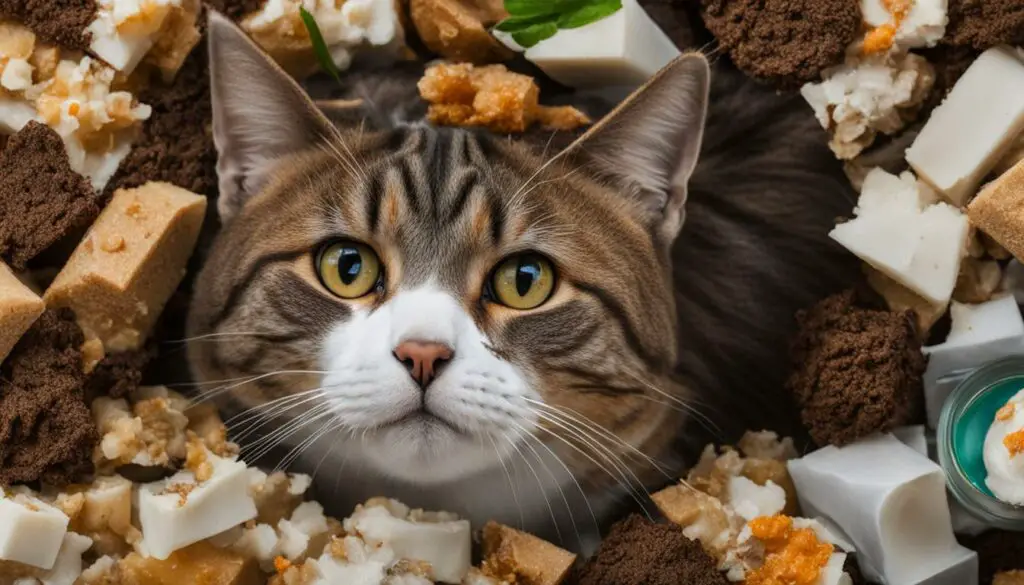
Conclusion
In conclusion, addressing cat vomiting is essential for the well-being of our feline companions. While occasional vomiting may not be cause for concern, frequent or persistent vomiting should prompt a visit to the veterinarian. By understanding the common causes of vomiting in cats, such as hairballs, dietary issues, and underlying health conditions, we can take appropriate measures to manage and prevent vomiting episodes.
Caring for vomiting cats involves a comprehensive approach. Regular grooming and the use of hairball prevention products can help reduce the occurrence of hairballs. Providing a balanced and appropriate diet, avoiding human foods, and ensuring gradual dietary changes can prevent vomiting due to dietary factors. When needed, veterinary care, including thorough examinations and diagnostic tests, can identify the underlying cause and guide treatment options.
By addressing cat vomiting promptly, we can improve the quality of life for our feline friends. Frequent or persistent vomiting can cause discomfort, dehydration, and nutritional imbalances. Therefore, it is crucial to recognize the signs of abnormal vomiting and seek veterinary care when necessary. Through proper management and preventive measures, we can help our cats lead happy and healthy lives.
FAQ
Is it normal for cats to vomit?
Occasional vomiting, especially due to hairballs, is common in cats. However, frequent or persistent vomiting may indicate an underlying health issue.
What are the common causes of vomiting in cats?
Common causes of vomiting in cats include hairballs, eating certain human foods, ingesting toxic plants or foreign objects, parasites, inflammatory bowel disease, and gastrointestinal infections.
How can I prevent hairballs in my cat?
Regular grooming, proper diet, and using hairball prevention products can help reduce the occurrence of hairballs in cats.
Can dietary factors contribute to vomiting in cats?
Yes, cats may vomit if they eat certain human foods, have food allergies or sensitivities, or if their diet changes abruptly. Providing a balanced and appropriate diet for your cat can help minimize the risk of vomiting due to dietary factors.
When should I seek veterinary care for my vomiting cat?
Frequent or persistent vomiting, especially when accompanied by other signs of illness such as lethargy, inappetence, or diarrhea, requires veterinary attention. It’s important to monitor your cat’s vomiting frequency and consult a veterinarian when necessary.
How is the underlying cause of vomiting in cats diagnosed?
A veterinarian will perform a thorough examination and may recommend diagnostic tests such as bloodwork or imaging to identify the underlying cause of the vomiting.
Are there remedies and management options for vomiting cats?
Depending on the underlying cause, remedies and management options may vary. Hairball lubricants, dietary modifications, and feeding strategies can be helpful. It’s best to consult a veterinarian for proper guidance and recommendations.
Are there preventive measures I can take to minimize cat vomiting?
Yes, preventive measures include regular grooming to reduce hairballs, cat-proofing the environment to avoid ingestion of foreign objects, and providing a balanced diet. Taking these measures can help minimize the occurrence of vomiting in cats.
What are the signs of abnormal vomiting in cats?
Signs of abnormal vomiting in cats include frequent or persistent vomiting, vomiting accompanied by other symptoms of illness, or vomiting that contains blood or foreign material. If you notice these signs, it’s important to seek timely veterinary care.
How does vomiting impact a cat’s well-being?
Frequent or persistent vomiting can cause discomfort, dehydration, and nutritional imbalances, affecting a cat’s overall well-being and quality of life. Managing cat health and addressing vomiting issues promptly can help improve their well-being.

